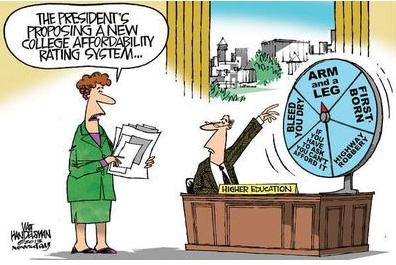Evaluating higher education costs. which have become exorbitant in the US.
Elliott Morss writes: Tuition and other costs have increased, but not primarily because of higher faculty salaries or more administrators. While these have gone up a small amount, fringe benefits, most notably health benefits, have increased more. And higher faculty costs have been offset by employing more part time faculty and increasing the use of teaching assistants. Student costs have increased substantially because of falling state and local government subsidies. In addition, higher education costs have risen significantly because of the hiring of a large number “non-teaching professionals.”
A major factor impacting school costs is the reduction in governments support and in particular, the reduction in state and local government assistance for public institutions. Table 1. – Costs of Attending Colleges/Universities (in 2011 $s)

Source: American Institutes for Research, Delta Cost Project, “Trends in College Spending: 2001–2011”
b. Growth in College/University Costs
Table 2 shows what happened to major school expenses per full-time equivalent (FTE) student in 2011 dollars. Several patterns are apparent. The fiscal squeeze resulting from the reduction in government support show up in the numbers for public and community colleges. And with the exception of these colleges, “student service” costs have increased dramatically.
Table 2. – Total Expenditures per FTE Student, 2001- 2011 (in 2011 $s)

Source: American Institutes for Research, Delta Cost Project, “Trends in College Spending: 2001–2011”
c. Staffing
Table 3 provides summary data on employees. The reduction in both Public University and Community College staffing is a manifestation of the reduction in government assistance. It is also notable how much higher the staffing levels of private institutions are than public.
Table 3. – FTE Employees per 1,000 FTE Students

Source: American Institutes for Research, Delta Cost Project, Donna Desrochers and Rita Kirshstein, “Issue Brief”, February 2014.
The large increase in “Other faculty” suggests a major substitution of full-time faculty by this group. It includes part-time as well as teaching assistants.
Table 4. – Growth in Staffing by Category, 1990 – 2012

Source: American Institutes for Research, Delta Cost Project, Donna Desrochers and Rita Kirshstein, op. cit.
d. Salaries
Table 5 provides data on what has happened to college/university wages and salaries. There have been substantial jumps in salaried research, but the funds for many of these payments come from funded research sources. The increase in payments for student services and maintenance are also notable.
Table 5. – Change in Wage/Salary Expenditures per Total FTE StaffFY 2002-FY 2010 (in 2011 $)

The evidence presented above indicate that for the 2001 – 2012 period, the costs of higher education grew, but not by much and not by the reasons usually cited – increased administrative staff and/or higher faculty salaries. The increases were felt because students are having to pay a significantly larger share of the tuition bill because government support has been declining. College/university costs are rising as the result of the hiring more non-faculty professionals. Faculty cost increases have been mitigated by hiring more part-time faculty and teaching assistants.

